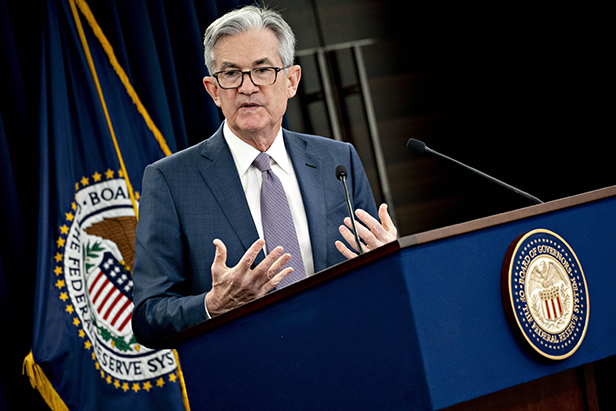
The Federal Reserve delivered the biggest interest-rate increase since 2000 and signaled it will keep hiking at that pace over the next couple of meetings, unleashing the most aggressive policy action in decades to combat soaring inflation.
The U.S. central bank's policy-setting Federal Open Market Committee (FOMC) on Wednesday voted unanimously to increase the benchmark rate by a half percentage point. It will also begin allowing its holdings of Treasuries and mortgage-backed securities to decline in June at an initial combined monthly pace of $47.5 billion, stepping up over three months to $95 billion.
Recommended For You
"Inflation is much too high, and we understand the hardship it is causing, and we are moving expeditiously to bring it back down," Chair Jerome Powell said in his first in-person press conference since the pandemic began. He added that there was "a broad sense on the committee that additional 50 basis point [bps] increases should be on the table for the next couple of meetings."
Powell's remarks ignited the strongest stock-market rally on the day of a Fed meeting in a decade, as he dashed speculation that the Fed was weighing an even larger increase of 75 bps in the months ahead, saying that it is "not something that the committee is actively considering."

Wednesday's increase in the FOMC's target for the federal funds rate, to a range of 0.75 percent to 1 percent, follows a quarter-point hike in March that ended two years of near-zero rates to help cushion the U.S. economy against the initial blow from Covid-19.
Goldman Sachs Group Inc. economists led by Jan Hatzius revised up their forecast following Powell's remarks to include a 50 bps increase in July, in addition to the half-point move they already expected in June.
"A fourth 50 basis point rate hike is possible in September too, but we are maintaining our forecast that the FOMC will revert to 25 basis point hikes at that point until we see additional data," they wrote in a note to clients. "We have not changed our terminal rate forecast of 3 percent to 3.25 percent, but we now expect to reach that rate" by the second quarter of next year, three months earlier than they previously predicted.
Policymakers, who widely signaled their intention to step up the pace of rate increases, are trying to curb the hottest inflation since the early 1980s. Back then, Chair Paul Volcker raised rates as high as 20 percent, crushing both inflation and the broader economy in the process. The Fed's hope this time around is that the combination of higher borrowing costs and a shrinking balance sheet will deliver a soft landing that avoids recession while tamping down inflation.
What Bloomberg Economists Say:
"Bloomberg Economics expects the Fed to hike by 50 bps at its next two meetings as well, with the fed funds rate exceeding FOMC members' neutral-rate estimate of about 2.5 percent in the last quarter of this year. At the announced pace, the balance-sheet runoff will see the Fed's portfolio approach its pre-pandemic size by 2024."
— Anna Wong, Yelena Shulyatyeva, Andrew Husby & Eliza Winger (economists)
The personal consumption expenditures price index, the Fed's preferred gauge, rose 6.6 percent in the year through March, more than triple the central bank's goal—and anger at price pressures among Americans is hammering the approval ratings of President Joe Biden, dimming the prospects for his Democrats in November midterm congressional elections.
A growing number of critics say the central bank waited too long to be able to stamp out inflation without causing a recession. Powell himself even told Congress in early March: "Hindsight says we should have moved earlier."
Investors had been increasingly betting the FOMC will opt for an even bigger rate increase, of three quarters of a percentage point, when it next meets in June—which would be the largest single hike since 1994. While officials have so far downplayed that idea, several have in recent weeks expressed a desire to "expeditiously" bring the federal funds rate to around 2.5 percent by the end of the year, a level they deem roughly "neutral" for the U.S. economy.
Powell said "it is certainly possible" that the Fed will decide over time that it needs to move rates to levels that are restrictive. "If higher rates are required, then we won't hesitate to deliver them," he told reporters, though he noted that that there is a "broad range of plausible levels of neutral," which officials in March estimated between 2 percent and 3 percent.
Officials decided to begin shrinking the Fed's $8.9 trillion balance sheet starting June 1, at a pace of $30 billion in Treasuries and $17.5 billion in mortgage-backed securities each month, stepping up over three months to $60 billion and $35 billion, respectively. The balance sheet had ballooned in size as the Fed aggressively bought securities to calm panic in financial markets and keep borrowing costs low as the pandemic spread.
The Fed said Wednesday that, "to ensure a smooth transition, the committee intends to slow and then stop the decline in the size of the balance sheet when reserve balances are somewhat above the level it judges to be consistent with ample reserves." Powell told Congress in early March that the process will take about three years, implying some $3 trillion in reductions.
Market expectations for a series of interest-rate increases have already pushed up borrowing costs and begun to constrain demand in rate-sensitive industries such as the housing market. The yield on the benchmark 10-year Treasury note rose to 3 percent this week for the first time since 2018. It was trading in late new York trade around 2.93 percent.
—With assistance from Kristy Scheuble, Liz Capo McCormick, Benjamin Purvis, Jonnelle Marte, Craig Torres & Reade Pickert.
© Touchpoint Markets, All Rights Reserved. Request academic re-use from www.copyright.com. All other uses, submit a request to [email protected]. For more inforrmation visit Asset & Logo Licensing.



